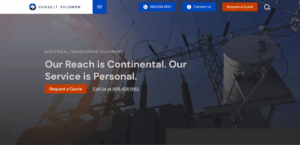Implementing a new technology can be a challenging process to navigate for any construction company. Frequently, the most difficult aspect of getting up and running with new systems isn’t the technicalities or even the logistics. Instead, the biggest hurdle that most construction companies face is getting employees to embrace and adopt new technology.
For Rachel Kines, Vice President of Procurement, and Scott Hicks, Director of Field Operations at the Eckardt Group, they too, initially met obstacles when implementing new field technology. “We have some employees who have worked in the industry for many years. They never wanted to touch a computer, let alone an iPad,” says Rachel. Nevertheless, with the right strategy, they were able to overcome these challenges and set their teams and projects up for success.
Below, they share more about their journey in the industry.
How did you end up working in the construction industry, and what do you love the most about it?
Rachel: Out of college, I had an engineering degree, but I didn’t know anything about electrical work. I just always liked the idea of construction. My parents had a building business growing up, so I’ve always been around construction my whole life–it was a natural fit.
The thing I love most about construction is seeing a project go from start to completion.
I love going by buildings that I’ve worked on knowing that a year prior, it was just dirt.
Scott: I started working in construction right out of high school. I went to college for a few years and just continued in the trades after that. I started as a helper and have made my way up to where I am now.
Similar to Rachel, my favorite part about working in construction is being able to drive by a finished project and see something tangible that you helped build. I have grandkids now, and as they get older, I enjoy being able to tell them about the projects I worked on by showing them.
What makes the Atlanta construction environment unique in both of your opinions?
Scott: The diversity of Atlanta’s construction industry has transformed the city over the years. We have strong growth in nearly every sector of construction from commercial and retail to industrial and healthcare–it’s an exciting market to be a part of.
What do you hope attendees leave with from your session at the upcoming Atlanta Roadshow?
Rachel: Our session is mainly for teams who have not fully made the jump to technology in construction. Many people in our industry are quite standoffish when it comes to transitioning from paper to electronic documents. It can feel overwhelming. However, I want our attendees to realize just how easy it is.
Even for our team, who made the switch to PlanGrid a year and a half ago, it took some convincing. We have some employees who have worked in the industry for many years. They never wanted to touch a computer, let alone an iPad. But once they saw how easy it was, they now love working with PlanGrid. They have all the information about the project in one place.
How has PlanGrid helped the Eckardt Group to build better?
Rachel: With PlanGrid, we know our field team always has a complete set of drawings including architectural, mechanical and plumbing. Our team needs all of this information to coordinate with various trades. With paper, it can be a good deal of back and forth to coordinate. If one thing gets marked up incorrectly, it could create a considerable amount of rework. Today, our team can spend two minutes looking at four different drawings of the same area and know exactly where something needs to be installed–that’s been a massive help.
Scott: With paper, we never have any idea if our electricians are working off the most recent set of sheets. PlanGrid ensures every crew has the right set of sheets and brings all the information together at their fingertips.
What was your “aha” moment when it comes to PlanGrid?
Rachel: With one click and drag, each and every change and revision is loaded into PlanGrid. To me, that’s huge because before, trying to slip sheet new revisions into an existing set was chaotic. Now, the process is automated, and it allows us to keep a living set of plans where no information or revision is ever lost.
Scott: Just overall, PlanGrid is really a simple and intuitive system for field response.



Responses